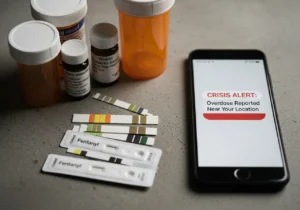In recent years, public-health researchers have identified a disturbing trend across North America: a rapid rise in “deaths of despair” among young adults. These deaths — caused by suicide, drug overdose and alcohol-related conditions — are reshaping mortality statistics and revealing deep social and economic challenges that traditional healthcare systems struggle to address.
While life expectancy in many parts of the world is improving, younger generations in North America are facing new threats that are emotional, social and behavioral rather than infectious or genetic. Understanding the drivers behind these losses is the first step toward reversing them.
What Are “Deaths of Despair”?
 The phrase deaths of despair was first popularized by economists Anne Case and Angus Deaton to describe mortality among working-age Americans driven by hopelessness, addiction and suicide. In 2025, that concept remains alarmingly relevant, especially for those aged 20 to 39.
The phrase deaths of despair was first popularized by economists Anne Case and Angus Deaton to describe mortality among working-age Americans driven by hopelessness, addiction and suicide. In 2025, that concept remains alarmingly relevant, especially for those aged 20 to 39.
These deaths stem from complex interactions between mental-health issues, economic uncertainty and the erosion of community and purpose. They represent a collision of social isolation, job insecurity, and insufficient access to affordable care.
The Current Statistics
Recent data from public-health organizations show that mortality linked to drug overdose and suicide among North American adults under 40 has increased by more than 40 % since 2010. In Canada and the United States alike, the overall mortality decline of the 1990s and early 2000s has stalled — and in some regions, reversed.
A 2025 report from Le Monde highlights that while global life expectancy is climbing again, the U.S. and Canada have seen flat or falling numbers due to the increase in preventable deaths among younger people.
Why Young Adults Are Most At Risk
- Mental-health crisis: Anxiety, depression and burnout rates have reached record highs, especially after the COVID-19 pandemic disrupted education, employment and stability.
- Substance abuse: Synthetic opioids like fentanyl continue to drive overdose deaths, while binge-drinking culture remains widespread.
- Economic pressure: Rising housing costs, unstable job markets and student-loan burdens create financial stress that fuels despair.
- Digital isolation: Despite being constantly connected online, many young people report feeling lonelier than ever before.
How the Crisis Differs by Region
In the United States, the Rust Belt and Appalachian regions have the highest rates of deaths of despair, linked to economic decline and unemployment. In Canada, Indigenous and rural communities face elevated risks due to lack of mental-health resources and cultural displacement.
Urban areas are not immune either — overdose deaths in major cities have surged as synthetic drugs spread faster than prevention efforts can contain them.
Health and Social Consequences
These deaths ripple far beyond individual families. They reduce labor-force participation, increase healthcare costs and deepen inequality. The Centers for Disease Control and Prevention estimates that every death of despair represents thousands of hours of lost productivity and millions of dollars in economic impact annually.
More importantly, they represent immeasurable emotional losses in communities already strained by social division and declining trust in institutions.
Preventing Deaths of Despair: What Works
 Preventing these tragedies requires an integrated approach that tackles mental health, addiction and social inequality together. Strategies include:
Preventing these tragedies requires an integrated approach that tackles mental health, addiction and social inequality together. Strategies include:
- Accessible mental-health services: Investing in affordable therapy, school-based counseling and 24-hour crisis hotlines can reduce suicides and self-harm.
- Harm reduction programs: Supervised consumption sites and naloxone distribution save lives and offer pathways to treatment.
- Community support networks: Peer programs and local outreach build connection and reduce isolation.
- Education and early intervention: Teaching coping skills and substance-use awareness in schools helps catch issues before they escalate.
- Economic and policy reform: Strengthening job security and housing access reduces financial stress that drives addiction and despair.
Emerging Community Solutions
Some cities in New England and the Pacific Northwest have adopted pilot projects combining mental-health clinics with career training centres. Others are investing in mobile crisis teams that respond to mental-health emergencies instead of police intervention. These programs show promising reductions in suicide and overdose rates over two years.
How Media and Public Awareness Play a Role
Responsible media coverage can reduce stigma and inspire change. By shifting the focus from sensationalism to education and resources, platforms like NewDeaths.com help spread awareness about preventable mortality and the human stories behind the numbers.
Frequently Asked Questions
Are deaths of despair limited to the United States?
No. Similar trends are emerging in Canada, the U.K. and parts of Europe, although the causes vary based on healthcare access and economic conditions.
Can AI and data science help predict these deaths?
Yes. Predictive models using social-media and health data are helping identify at-risk populations for early intervention, though privacy concerns must be carefully managed.
What can families do to support loved ones?
Open communication is vital. Encouraging professional help, reducing stigma and building routine social support can make a life-saving difference.
Conclusion
The rise of deaths of despair among young adults is not inevitable — it is preventable. These losses reflect societal failures that can be corrected through compassion, policy innovation and community engagement. By investing in mental-health care, strengthening social safety nets and promoting connection over isolation, North America can reverse this distressing trend and restore hope to a generation that needs it most.
